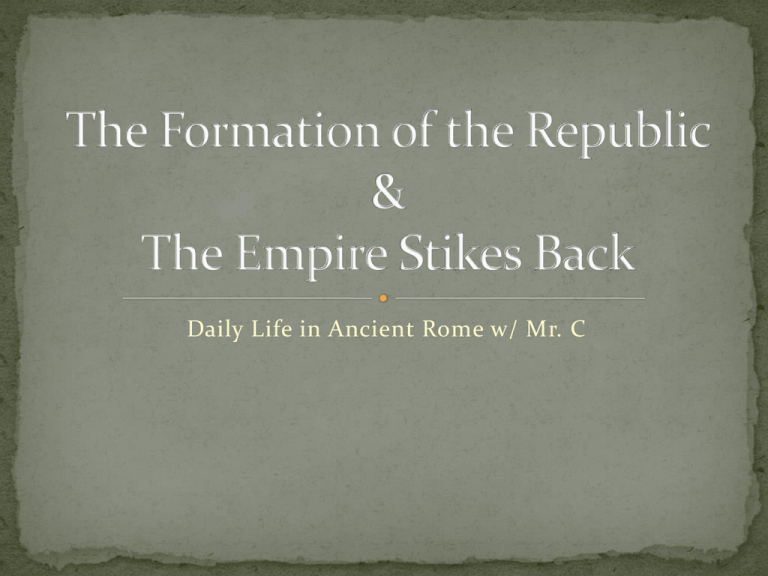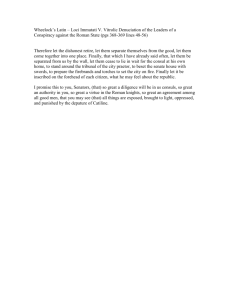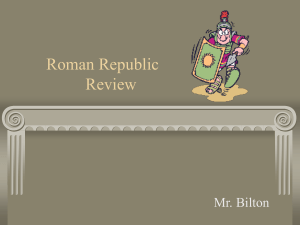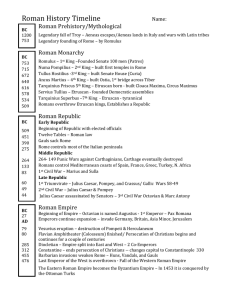File - Mr. C at Hamilton
advertisement

Daily Life in Ancient Rome w/ Mr. C An Etruscan temple, to meet religious requirements, was located on a north-south axis and stood on a high podium with a fourcolumned porch in front of three doors leading to three parallel rooms for the three chief Etruscan gods. The brilliantly painted terracotta statuary that decorated the roof along the eaves, ridge pole, and at the gable ends also served the practical purpose of hiding and protecting tile joints and rafter ends. Plaques with low-relief figures adorned the entablature. Pairing: Husband & Wife Etruscan state government was essentially a theocracy. Etruscans was vertical, or generational. They kept The political unit of track of six generations. Etruscan society was the city-state. The names of persons are generally binomial: Vethur Hathisna, Avile Repesuna, Fasti Aneina. Kinship among the Catha and Usil, the sun The Etruscans believed Tivr, the moon in intimate contact with divinity. They did nothing without proper consultation with the gods and signs from them. Selvan, a civil god Turan, the goddess of love Laran, the god of war Leinth, the goddess of death Maris, Thalna, Turms and the ever-popular Fufluns Augery Auspices ADOPT The power of religion and mysticism. The Etruscans were profoundly and eternally influenced by mysticism and what we would generally refer to as "superstition". REJECT The position of women in Etruscan society. As opposed to Roman and Greek societies, Etruscan women sat with their husbands at banquets, had their own personal possessions and were actively involved in day to day politics. From the point of view of Roman morality Etruscan women were immoral and dissolute. Roman Monarchy (753 B.C. – 510 B.C.) Roman Republic (509 B.C. – 44 B.C.) (Mar. 15= The Ides of March). Murder of Caesar. 44 B.C Roman Empire (30 B.C. – 476 A.D./1453 A.D.) Caesar Augustus, 1st citizen Imperatur 1. Romulus 753-715 B.C. 3. Tullus Hostilius 673-642 Romulus was the legendary B.C. Tullus Hostilius doubled the population of Rome, added Alban nobles to the Senate of Rome, and built the Curia Hostilia. He was a warrior. 4. Ancus Martius 642-617 B.C. Ancus Marcius was a grandson of Numa Pompilius and a bridge builder. The bridge across the Tiber is credited to Ancus Marcius. founder of Rome. The Sabine king of Cures, Tatius, co-ruled with Romulus. 2. Numa Pompilius 715-673 B.C. Numa Pompilius is credited with many of the ancient religious conventions of ancient Rome. 5. L. Tarquinius Priscus 616-579 B.C. The first of these new kings, it is said, came from the Etruscan city of Tarquinii, from which he derived his name. The story is told that, as he approached the city, an eagle came from the sky, and, lifting his cap from his head, replaced it. His wife, who was skilled in the Etruscan art of augury, regarded the eagle as a messenger from heaven, and its act as a sign that her husband was to acquire honor and power. Tarquinius Priscus had a Corinthian father. Tarquin created 100 new senators and expanded Rome. He also established the Roman games. 6. Servius Tullius 578-535 B.C. The next king was Servius Tullius, who is said to have been the son of a slave in the royal household, and whom the gods favored by mysterious signs. Servius Tullius was the son-in-law of Tarquinius Priscus. He divided the Roman citizens into tribes and fixed the military obligations of 5 census-determined classes. 7. Tarquinius Superbus (Tarquin the Proud) 534-510 B.C. Tradition represents the last king, Tarquinius Superbus, as a cruel despot. He obtained the throne by murder, and ruled without the consent of the senate or the people. He loved power and pomp. He was forcibly ousted by Brutus. Having witnessed the problems of monarchy on their own land, and aristocracy and democracy among the Greeks, the Romans opted for a mixed form of government, with 3 branches of government. Consul Senate Assembly Consuls - The Monarchical Branch of Roman Government in the Roman Republic: Two magistrates called consuls carried on the functions of the former kings, holding supreme civil and military authority in Republican Rome. However, unlike the kings, the office of consul lasted for only one year. At the end of their year in office, the ex-consuls became senators for life, unless ousted by the censors. The 1-year term, veto, and co-consulship were safeguards to prevent one of the consuls from wielding too much power. Senate - The Aristocratic Branch of Roman Government in the Roman Republic: Senate (senatus = council of elders [related to the word "senior"]) was the advisory branch of the Roman government, early on composed of about 300 citizens who served for life. They were chosen by the kings, at first, then by the consuls, and by the end of the 4th century, by the censors. The ranks of the Senate, drawn from ex-consuls and other officers. Property requirements changed with the era. At first senators were only patricians but in time plebeians joined their ranks. Assembly - The Democratic Branch of Roman Government in the Roman Republic: The Assembly of Centuries (comitia centuriata), which was composed of all members of the army, elected consuls annually. The Assembly of Tribes (comitia tributa), composed of all citizens, approved or rejected laws and decided issues of war and peace. In ancient Rome, censors were census-takers and morality keepers. The comitia curiata elected the censores. At first their term of office was a lustrum or about 5 years, but it was soon reduced to a period of 18 months. Although the censors were awarded no imperium (roughly, power), and therefore had no lictors to serve as axe-carrying bodyguards, the office was above the consul and second only to the office of dictator in dignity. (339 B.C.) One of the censors must be a plebeian. Carthago delenda est Etruscans and Gauls squeezed out by Latins 290- conquered central Italy then Samnites in South 265 took over Greek city states Why? Staying power of army Won over conquered people Became Roman citizens gradual struggle between the patrician and plebeian classes 2 consuls and Senate made up of patricians popular assemblies established with a representative tribune- veto power 450 B.C. 12 Tables Roman Law codified Result- increase of privileges for plebes Major rival in Med- Phoenician Carthage First Punic War 264-42- copied ships and corvus out of Sicily Second Punic war 218-202- Hannibal 216 Battle of Camnae Third- treaty infringement trumped up Cato’s speech Carthago delenda est” Carthage plowed and sowed with salt Result Rome now the POWER in the Mediterranean Graft*, corruption, struggle between patrician and plebeians Gracchi Brothers Tiberias and Gaius Marius consul 6 x Sulla- general seized Rome in 82 BCE restored power to Senate set precedent * unscrupulous use of a politician's authority for personal gain. First Triumvirate Julius Caesar, Pompey, Crassus Julius Caesar challenges the Senate crosses the Rubicon 47 BCE virtual ruler, increased Senate to 900 44 BCE assassinated, Second Triumvirate Octavius, Marc Antony, Lepidus Battle of Actium 31 BCE End of an era Caesar Augustus- purpose “to restore the republic” 27 B.C. Augustus become “First Citizen” Princeps ended strife- beginning of Pax Romanae tried to impact life- morality, building sculpture- deified him, literature as well Consolidation- of power/ Senate limited SPQR Senatus Populusque Romanus- banner Ever expanding- see maps- spread Pax Romanae Politically - emperor/ dictatorship Extended Roman citizenship as they spread The Roman family- gradual less influence for fathers family strong unit- run like the state women become more independent- socially and ownership politically active as wives of emperors- Livia, wife of CA Food Bathrooms City Life Religion Women War Home Life Y mucho, mucho mas!







